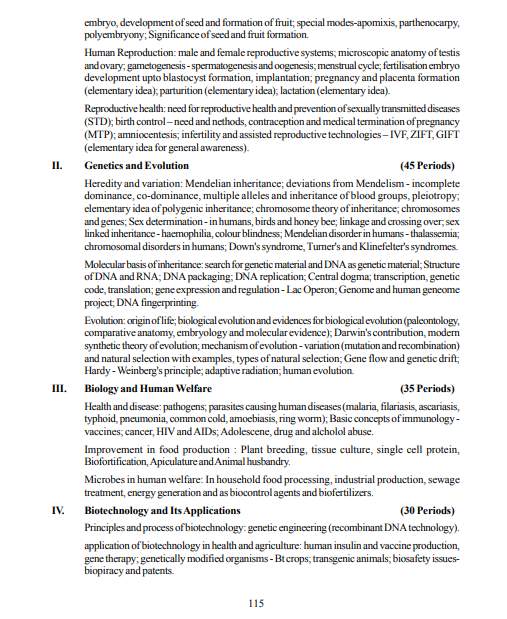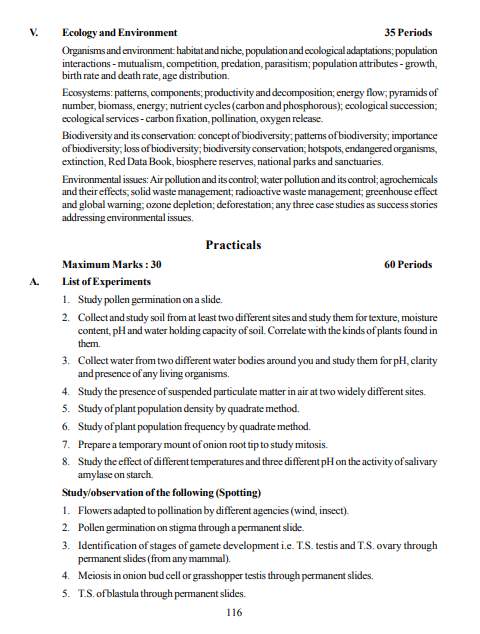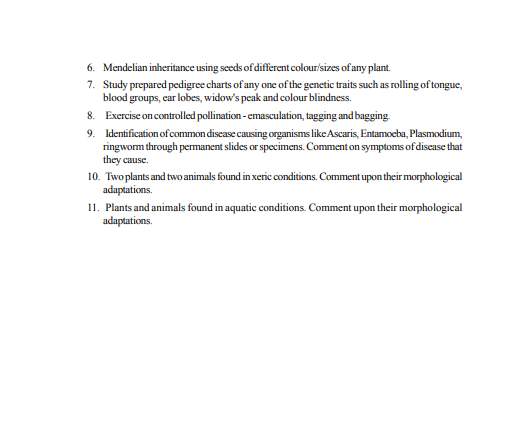| Re: Biology Syllabus for Class 12 CBSE
Biology Class 12 Syllabus
Exam Structure
Unit Title Marks
VI Reproduction 14
VII Genetics and Evolution 18
VIII Biology and Human Welfare 14
IX Biotechnology and its Applications 10
X Ecology and Environment 14
Total 70
Unit VI. Reproduction
Chapter-1: Reproduction in Organisms
Reproduction, a characteristic feature of all organisms for continuation of species; Asexual reproduction Modes of reproduction-Asexual and sexual reproduction; Modes-Binary fission, sporulation, budding, gemmule, fragmentation; vegetative propagation in plants.
Chapter-2: Sexual Reproduction in Flowering Plants
Flower structure; Development of male and female gametophytes; Pollination-types, agencies and examples; Outbreedings devices; Pollen-Pistil interaction; Double fertilization; Post fertilization events-Development of endosperm and embryo, Development of seed and formation of fruit; Special modes-apomixis, parthenocarpy, polyembryony; Significance of seed and fruit formation.
Chapter-3: Human Reproduction
Male and female reproductive systems; Microscopic anatomy of testis and ovary; Gametogenesis-spermatogenesis & oogenesis; Menstrual cycle; Fertilisation embryo development upto blastocyst formation, implantation; Pregnancy and placenta formation (Elementary idea); Parturition (Elementary idea); Lactation (Elementary idea).
Chapter-4: Reproductive Health
Need for reproductive health and prevention of sexually transmitted diseases (STD); Birth control – Need and Methods, Contraception and Medical Termination of Pregnancy (MTP); Amniocentesis; Infertility and assisted reproductive technologies - IVF, ZIFT, GIFT (Elementary idea for general awareness).
Unit VII. Genetics and Evolution
Chapter-5: Principles of Inheritance and Variation
Mendelian Inheritance; Deviations from Mendelism-Incomplete dominance, Co-dominance, Multiple alleles and Inheritance of blood groups, Pleiotropy; Elementary idea of polygenic inheritance; Chromosome theory of inheritance; Chromosomes and genes; Sex determination - in humans, birds, honey bee; Linkage and crossing over; Sex linked inheritance - Haemophilia, Colour blindness; Mendelian disorder in humans - Thalassemia; chromosomal disorders in humans; Down's syndrome, Turner's and Klinefelter's syndromes.
Chapter-6: Molecular Basis of Inheritance
Search for genetic material and DNA as genetic material; Structure of DNA and RNA; DNA packaging; DNA replication; Central dogma; Transcription, genetic code, translation; Gene expression and regulation - Lac Operon; Genome and human ganeome project; DNA fingerprinting.
Chapter-7: Evolution
Origin of life; Biological evolution and evidences for biological evolution (Paleontological, comparative anatomy, embryology and molecular evidence); Darwin's contribution, Modern Synthetic theory of Evolution; Mechanism of evolution - Variation (Mutation and Recombination) and Natural Selection with examples, types of natural selection; Gene flow and genetic drift; Hardy - Weinberg's principle; Adaptive Radiation; Human evolution.
Unit VIII. Biology and Human Welfare
Chapter-8: Human Health and Diseases
Pathogens; parasites causing human diseases (Malaria, Filariasis, Ascariasis, Typhoid, Pneumonia, common cold, amoebiasis, ring worm); Basic concepts of immunology - vaccines; Cancer, HIV and AIDs; Adolescene, drug and alcholol abuse.
Chapter-9: Strategies for Enhancement in Food Production
Improvement in food production : Plant breeding, tissue culture, single cell protein, Biofortification, Apiculature and Animal husbandry.
Chapter-10: Microbes in Human Welfare
In household food processing, industrial production, sewage treatment, energy generation and as biocontrol agents and biofertilizers. Antibiotics; production and judicious use.
Unit IX. Biotechnology and Its Applications
Chapter-11: Biotechnology - Principles and Processes
Genetic engineering (Recombinant DNA technology).
Chapter-12: Biotechnology and its Application
Application of Biotechnology in health and agriculture: Human insulin and vaccine production, gene therapy; Genetically modified organisms-Bt crops; Transgenic Animals; biosafety issues, biopiracy and patents.
Unit X. Ecology and Environment
Chapter-13: Organisms and Populations
Organisms and environment: Habitat and niche, Population and ecological adaptations; Population interactions-mutualism, competition, predation, parasitism; Population attributesgrowth, birth rate and death rate, age distribution.
Chapter-14: Ecosystem
Patterns, components; productivity and decomposition; energy flow; pyramids of number, biomass, energy; nutrient cycles (carbon and phosphorous); ecological succession; ecological services - carbon fixation, pollination, seed dispersal, oxygen release (in brief).
Chapter-15: Biodiversity and its Conservation
Concept of biodiversity; patterns of biodiversity; importance of biodiversity; loss of biodiversity; biodiversity conservation; hotspots, endangered organisms, extinction, Red Data Book, biosphere reserves, national parks, sanctuaries and Ramsar sites.
Chapter-16: Environmental Issues
Air pollution and its control; water pollution and its control; agrochemicals and their effects; solid waste management; radioactive waste management; greenhouse effect and climate change; ozone layer depletion; deforestation; any one case study as success story addressing environmental issue(s).
|



